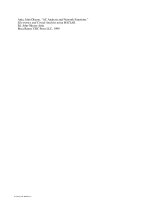Electronics and Circuit Analysis Using MATLAB P3
Bạn đang xem bản rút gọn của tài liệu. Xem và tải ngay bản đầy đủ của tài liệu tại đây (196.21 KB, 17 trang )
Attia, John Okyere. “Control Statements .”
Electronics and Circuit Analysis using MATLAB.
Ed. John Okyere Attia
Boca Raton: CRC Press LLC, 1999
© 1999 by CRC PRESS LLC
CHAPTER THREE
CONTROL STATEMENTS
3.1 FOR LOOPS
“FOR” loops allow a statement or group of statements to be repeated a fixed
number of times. The general form of a for loop is
for index = expression
statement group X
end
The expression is a matrix and the statement group X is repeated as many
times as the number of elements in the columns of the expression matrix. The
index takes on the elemental values in the matrix expression. Usually, the ex-
pression is something like
m:n or m:i:n
where m is the beginning value, n the ending value, and i is the increment.
Suppose we would like to find the squares of all the integers starting from 1 to
100. We could use the following statements to solve the problem:
sum = 0;
for i = 1:100
sum = sum + i^2;
end
sum
For loops can be nested, and it is recommended that the loop be indented for
readability. Suppose we want to fill 10-by-20 matrix, b, with an element value
equal to unity, the following statements can be used to perform the operation.
%
n = 10; % number of rows
m = 20; % number of columns
for i = 1:n
for j = 1:m
b(i,j) = 1; % semicolon suppresses printing in the loop
end
end
© 1999 CRC Press LLC
© 1999 CRC Press LLC
b % display the result
%
It is important to note that each for statement group must end with the word
end. The following program illustrates the use of a for loop.
Example 3.1
The horizontal displacement
xt
()
and vertical displacement
yt
()
are given
with respect to time,
t,
as
xt t
yt t
()
( ) sin( )
=
=
2
For
t
= 0 to 10 ms, determine the values of
xt
()
and
yt
()
. Use the values to
plot
xt
()
versus
yt
()
.
Solution
:
MATLAB Script
%
for i= 0:10
x(i+1) = 2*i;
y(i+1) = 2*sin(i);
end
plot(x,y)
Figure 3.1 shows the plots of
xt
()
and
yt
()
.
© 1999 CRC Press LLC
© 1999 CRC Press LLC
Figure 3.1 Plot of x versus y.
3.2 IF STATEMENTS
IF statements use relational or logical operations to determine what steps to
perform in the solution of a problem. The relational operators in MATLAB
for comparing two matrices of equal size are shown in Table 3.1.
Table 3.1
Relational Operators
RELATIONAL
OPERATOR
MEANING
< less than
<= less than or equal
> greater than
>= greater than or equal
== equal
~= not equal
© 1999 CRC Press LLC
© 1999 CRC Press LLC
When any of the above relational operators are used, a comparison is done be-
tween the pairs of corresponding elements. The result is a matrix of ones and
zeros, with one representing TRUE and zero FALSE. For example, if
a
= [1 2 3 3 3 6];
b
= [1 2 3 4 5 6];
a
==
b
The answer obtained is
ans =
1 1 1 0 0 1
The 1s indicate the elements in vectors
a
and
b
that are the same and 0s are the
ones that are different.
There are three logical operators in MATLAB. These are shown in Table 3.2.
Table 3.2
Logical Operators
LOGICAL OPERATOR
SYMBOL
MEANING
& and
! or
~ not
Logical operators work element-wise and are usually used on 0-1 matrices,
such as those generated by relational operators. The & and ! operators com-
pare two matrices of equal dimensions. If A and B are 0-1 matrices, then A&B
is another 0-1 matrix with ones representing TRUE and zeros FALSE. The
NOT(~) operator is a unary operator. The expression ~C returns 1 where C is
zero and 0 when C is nonzero.
There are several variations of the IF statement:
• simple if statement
• nested if statement
• if-else statement
© 1999 CRC Press LLC
© 1999 CRC Press LLC
• if-elseif statement
• if-elseif-else statement.
• The general form of the simple if statement is
if logical expression 1
statement group 1
end
In the case of a simple if statement, if the logical expression1 is true, the state-
ment group 1 is executed. However, if the logical expression is false, the
statement group 1 is bypassed and the program control jumps to the statement
that follows the end statement.
• The general form of a nested if statement is
if logical expression 1
statement group 1
if logical expression 2
statement group 2
end
statement group 3
end
statement group 4
The program control is such that if expression 1 is true, then statement groups
1 and 3 are executed. If the logical expression 2 is also true, the statement
groups 1 and 2 will be executed before executing statement group 3. If logical
expression 1 is false, we jump to statement group 4 without executing state-
ment groups 1, 2 and 3.
• The if-else statement allows one to execute one set of statements if a
logical expression is true and a different set of statements if the logical
statement is false. The general form of the if-else statement is
if logical expression 1
statement group 1
else
statement group 2
end
© 1999 CRC Press LLC
© 1999 CRC Press LLC









